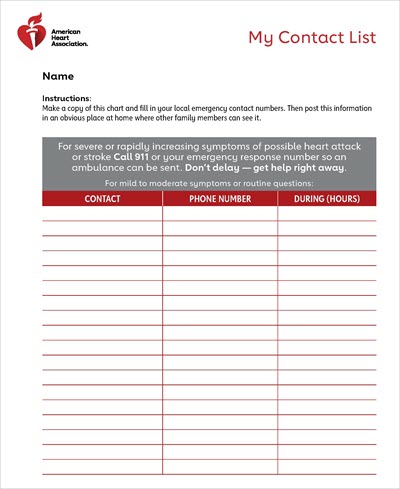Taking Care of Yourself

The first days and weeks after you get out of the hospital following a cardiac event or diagnosis can be a frightening, confusing time. You may be taking new medications and following many new instructions. You may sometimes feel as if your world has changed.
Focusing on three simple tasks can help you manage your condition while you recover and regain your strength:
Goal 1: Know your treatment plan
The goal of cardiac rehab is to help you learn to reduce the risk factors — such as smoking, high blood pressure, high cholesterol, physical inactivity, diabetes and being overweight — that increase your chances of future health problems.
The American Heart Association and the American College of Cardiology have developed national guidelines to help you reduce the risk of future problems. These guidelines can help your health care team develop a treatment plan — including medications and lifestyle changes such as diet and physical activity — for all your risk factors. Make sure you know your goal numbers and work with your health care team to achieve them.
Smoking
Quit for good. Smoking is the leading preventable cause of death and disability in the United States. Cigarette smoking results in a much higher risk of dying of coronary heart disease. Smoking robs the heart of oxygen-rich blood and increases the effects of other risk factors, including blood pressure, blood cholesterol levels and physical inactivity. Thinking about quitting? We can help.
Blood pressure
Normal blood pressure is less than 120/80 mm Hg (systolic pressure is less than 120 AND diastolic pressure is less than 80). Elevated is systolic pressure from 120-129 AND diastolic pressure less than 80. High blood pressure is systolic pressure of 130 or higher OR diastolic pressure of 80 or higher.
When blood pressure is higher, your heart has to work harder. Changes in health habits such as losing weight, eating less sodium (salt) and engaging in regular physical activity can help lower blood pressure. If you have high blood pressure, staying on your medications is critical to prevent heart attacks, strokes, kidney disease and heart failure.
Monitor your blood pressure as your health care professional advises. Keep track of your readings with our blood pressure log (PDF).
Learn more about high blood pressure.
Blood cholesterol
Get your cholesterol checked and talk to your health care team about your numbers and how they impact your overall risk.
High blood cholesterol occurs if your body makes too much cholesterol or if you eat foods that have too much saturated fat and trans fat. For people with coronary heart disease who are at high risk, treatment focuses on reducing cholesterol. To lower your cholesterol, you may need to change your eating habits and lose weight. Ask your health care professionals whether you should be taking a cholesterol medication along with making these lifestyle changes.
Get tips on managing your cholesterol.
Physical activity
At least 150 minutes of moderate-intensity physical activity (brisk walking, jogging, cycling, etc.) is recommended per week
Regular physical activity has many benefits, such as helping you quit smoking, lose weight, reduce stress, sleep better, lower blood pressure and increase HDL cholesterol. Doing aerobic exercise — using large muscles of the legs and arms — helps your heart work more efficiently. Physical activities to improve your strength, flexibility and balance help you stay agile as you age and reduce your risk of falls.
Learn more about getting active.
Weight
Ideal body mass index (BMI) is 18.5-24.9 kg/m2.
Your waist circumference also helps determine whether you need to lose weight — all you need is an ordinary measuring tape. Ideal waist circumference is not more than 40 inches for men and not more than 35 inches for women. (Recommendations are lower for people of Asian descent: 37-39 inches for men and 31-35 inches for women.)
Weight loss may help lower your blood pressure and improve both cholesterol and blood sugar. The tips and tools on this website can help you lose five to 10 pounds.
Learn more about eating right and losing weight.
Blood sugar (glucose)
Normal fasting blood glucose is less than 100 mg/dL.
Diabetes
If you are diabetic, an HbA1c (glycosylated hemoglobin) level below 7% is recommended, but your safe range may be lower or higher.
Managing diabetes is important to your long-term health, especially if you have heart disease. Diabetes is best controlled by diet, weight loss, physical activity, medications and regular monitoring of your blood sugar. Many studies have shown that medications such as statins, aspirin, ACE inhibitors and beta blockers, which lower the risk of future heart problems, have even greater benefit in people with diabetes. That's why it's important for you to start and continue taking these medications. They can help to lower your cholesterol and blood pressure, which will decrease your risk of heart attack, stroke and kidney disease.
Learn more about managing diabetes.
Goal 2: Recognize your symptoms
You need to know, and know what to do about, symptoms that may suggest a heart attack or stroke. Reacting quickly is key. If you have any of the listed symptoms, call 911 immediately or have someone take you to the nearest emergency room.
The warning signs of heart attack are:
- Chest discomfort. Most heart attacks involve discomfort in the center of the chest that lasts more than a few minutes or that goes away and comes back. It can feel like uncomfortable pressure, squeezing, fullness or pain.
- Discomfort in other areas of the upper body. Symptoms can include pain or discomfort in one or both arms, the back, neck, jaw or stomach.
- Shortness of breath with or without chest discomfort.
- Other signs may include breaking out in a cold sweat, nausea or lightheadedness.
The warning signs of stroke are sudden:
- Numbness or weakness of the face, arm or leg, especially on one side of the body.
- Confusion, trouble speaking or understanding.
- Trouble seeing in one or both eyes.
- Trouble walking, dizziness, loss of balance or coordination.
- Severe headache with no known cause.
“F.A.S.T.” is an easy way to remember how to recognize a stroke and what to do.
Spot a stroke FAST:
Face drooping.
Arm weakness.
Speech difficulty.
Time to call 911.
Not all these signs occur in every heart attack or stroke. Sometimes they go away and return. If some occur, get help right away. Every minute counts if you're having a heart attack or stroke. The sooner you get medical help, the more likely you are to recover.
Don't delay — you can save your heart or brain from severe damage if you act quickly. Learn these symptoms and share them with your family, friends and caregivers.
Women sometimes have different symptoms than men, so learn the signs of heart attack in women.
Angina
Angina usually feels like a squeezing, burning, pressure, heaviness or tightness under the breastbone. It may also spread to one or both arms, your back, neck, jaw or stomach. Some people, especially women and people with diabetes, may not have typical chest discomfort. Their symptoms may be shortness of breath or feeling very tired.
Tell your health care professional if you think you're having angina. Knowing how often your angina occurs will help them decide whether you need a change in your medications or other treatments. You can use the angina log (PDF) to keep a record of your symptoms.
Learn more about angina pectoris and unstable angina.
Your health care professional might give you a prescription for nitroglycerin. This medication comes in a tablet or spray form and provides immediate relief of angina.
If you don't have relief of your angina pain after taking your nitroglycerin, you or a family member should call 911 or your emergency response number so you can get to the hospital right away.
Nitroglycerin tablets may lose their strength, so throw them away after six months and get a new supply. Nitroglycerin comes in a small, easy-to-carry container. Keep several tablets with you at all times.
You should always report these changes to your health care team:
- Any new chest discomfort (angina)
OR any change in how often, how intensely or how long you have it. - Any new shortness of breath, especially with physical activity.
- Feeling extremely tired.
- Feeling dizzy or fainting.
Goal 3: Make a plan for getting medical help
You and your loved ones will feel better and be more prepared if you know who to call about discomfort and other worrisome symptoms. Your early response to symptoms may prevent an emergency.
Find out in advance:
- What days and times you can reach your health care professional’s office or answering service.
- If you can contact another health care professional if yours isn't available.
- Whether you have telephone access to an advice nurse or care manager.
Print the Medical Contact List (PDF), complete it and post it in an obvious place at home where other family members can see it.
Remember — if you think you're having symptoms of a heart attack or stroke, call 911 or have someone take you to the nearest emergency room immediately.







